Let’s Not Repeat Mistakes: Don’t Destroy the Municipal Building
(This is an opinion piece I submitted to New Raleigh as part of their discussion on whether or not the Municipal Building should be saved. Read their article for more viewpoints and discussion.)
In mid-March, the Raleigh City Council stalled on the resolution to replace the old Municipal Building with the new Clarence Lightner Public Safety Center. In the past few days, there has been a renewed push in exploring ways to overcome objecting Councillors’ concerns about the cost of the project.
The debates both for and against building the new Lightner Center had valid supporting arguments, but noticeably absent from the debate was the case for preserving the existing structure. That has changed in recent weeks, and I’m going to add my voice to the growing chorus of citizens calling for preservation rather than destruction.
Some Background: Raleigh’s Modern Legacy
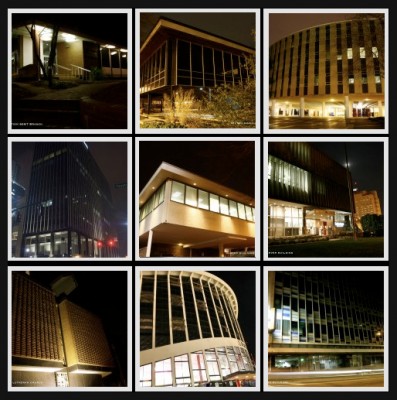
Above: some of the buildings photographed for an essay on Modern Architecture in Raleigh
Many cities are known for a dominant architectural style. Miami, Asheville, and Durham are known for their for their splendid Art Deco buildings. New York, San Francisco, and Detroit have large swaths of beautiful Victorian-era architecture. Chicago, Los Angeles, and to a lesser extent, Raleigh, are all known for their modernist buildings.
The Municipal Building that would be destroyed is one of Raleigh’s buildings that contributes to this legacy.
Anchoring Nash Square
Nash Square is in a unique position with regard to the buildings that sit on its perimeter: every side of the square has a modernist structure. In addition to the Municipal Building, there is the News & Observer Building, Raleigh Fire Station One, and the original location of the Raleigh Times. The old Raleigh Times building was retrofitted with a modern facade at some point in the late 60s or early 70s.
Most of Raleigh’s modern buildings (and in particular the residential ones) are on the west side of town.
Designed By a Local Legend
No other architect has received as much attention on this blog as G. Milton Small. His office building on Brooks Avenue was one of the first architecture articles to be posted to this site, and at one point I proclaimed him as my favorite architect. Milton Small left a mark on Raleigh like few others have.
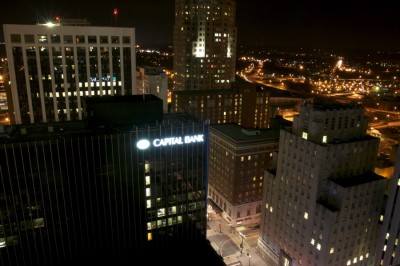
Lower left is a modernist high rise which was designed in part by Small, known as the “Little Seagram Building.” It bears a striking resemblance with the building in New York designed by his mentor.
Historically, Raleigh has been a follower and not a leader when it comes to architecture and trends in design. Small was at the forefront of those that brought these trends to Raleigh. He was a student and disciple of perhaps the most influential modernist architect of all time, Ludwig Mies van der Rohe. Lured to Raleigh like so many others in the early days of the College of Design by Dean Kamphoefner, he had a role in educating others as well as running his own firm.
Why This Building Matters
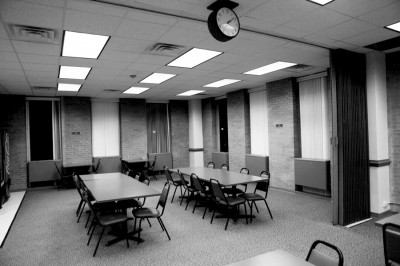
Recently a cafeteria, above is where Raleigh City Councillors used to meet when the building was the seat of Raleigh government
The building served as the seat of Raleigh Municipal Government for a long time. Decades of decisions that shaped Raleigh’s current path of development were made here.
When the City Councilors of 1959-1960 met in this new building, Raleigh was a much different place. Officers of the RPD would check in via call boxes and payphones. Schools and businesses were segregated. Jesse Helms was young man serving on City Council.
The previous buildings which housed City Government have long since been demolished. The most recent location (above), ironically, was razed to make way for the BB&T Building (now Capital Bank Plaza) which was designed in part by Milton Small.
Looking to the Past
Everything comes full circle–we generally adore the architecture of our grandparents but not of our parents’ generation. Victorian architecture was very out of fashion at the time in which Raleigh razed most buildings in this style. It wasn’t until a good time later before people began to appreciate it.
Looking to the Future
We’re at a unique point–more and more people are beginning to come around to the beauty of the modern style. So much, in fact, that George Smart of Triangle Modernist Houses has an ever-increasing crowd of fans taking tours of modernist homes. We have an opportunity before us to save this building at the right time, when it is appreciated by the citizens of Raleigh.
The building has been vacated as the Raleigh Police Department has relocated its headquarters. It could serve as commercial or municipal office space. In either scenario, we gain more by utilizing it rather than razing it. Not all buildings warrant being preserved simply because they have been around for a while. This building matters though, and can be modernized and utilized in other ways–a process far more “green” than building a LEED-certified structure.
I’m in favor of building the Lightner Center–our city’s first responders need a state of the art facility. But let’s build it somewhere else, such as on top of one of our countless parking lots. We have the opportunity to preserve a building that embodies an architectural style that Raleigh is known for–we shouldn’t squander it.
Further Reading:
- A Reflection on Modernism in Raleigh (Previous essay on Goodnight, Raleigh!)
- Don’t Demolish the Municipal Building! (Facebook group)
- Renovate, Don’t Demolish Raleigh Municipal Building (Elizabeth Sappenfield, Preservation NC)
- Don’t Remove Our History, Community, or Art (Bonner Gaylord, City Councillor)
- G. Milton Small (Triangle Modernist Houses Bio)
More images from the Municipal Building/Former RPD Headquarters:
Special thanks to Jim Shugrue for giving me a tour of RPD Headquarters before it was vacated.

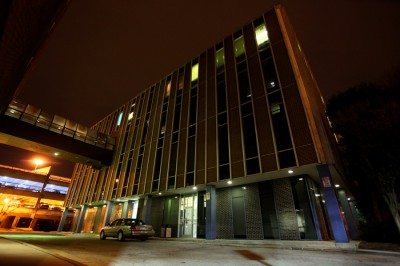
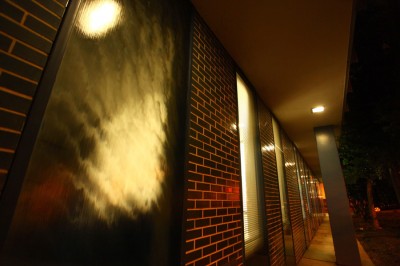
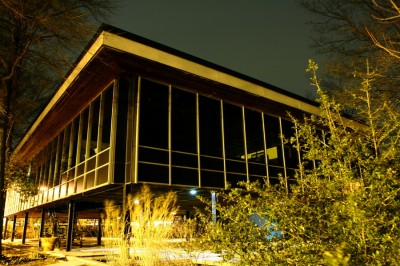

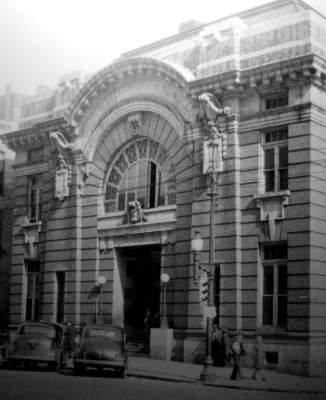
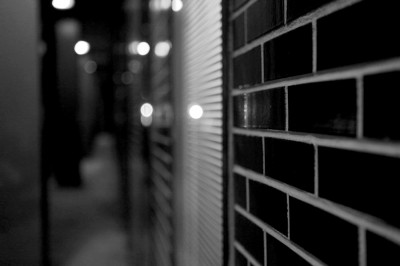
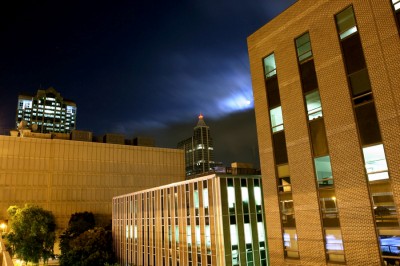
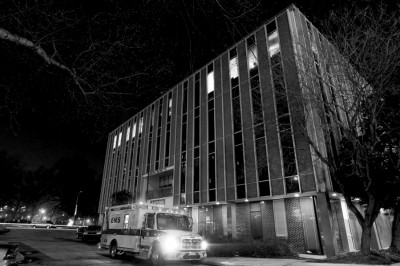
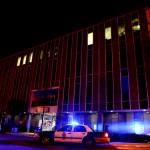

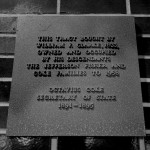
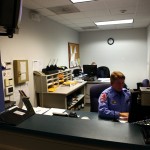
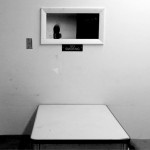
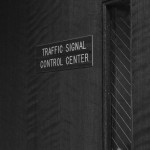



 Sign up for the Newsletter
Sign up for the Newsletter
05/19/2010
Wo.
Fascinating article and fleshed out extremely well. Great subject but greater writing!
Excellence.
05/27/2010
Doesn’t “preserve and build somewhere else” lead to urban sprawl? I’m not saying that I don’t appreciate the architecture, design, and historical significance of the municipal building, but there is something to be said for a compact downtown.
05/31/2010
It doesn’t have to. I am in support of the new building. My argument is that we have enough parking lots upon which to put it. One possible location is the current parking lot where the Reynolds Tower was going to go. Parking is a problem that downtown Raleigh doesn’t have.
06/02/2010
Hmmm… what is “New Raleigh”??? Raleigh has recently/officially been declared the most livable city in the country, and the population crush that has hit so many other “hip” cities is just getting started.
I have seen this before in Kansas City. We can only hope that the wonderful people that are snatching up properties like the EB Bain Waterworks have the funding to save the most important landmarks. There is going to be alot of razing of the heart and soul of our community.
07/01/2010
An ugly, cheap “erector set” box. Still utilitarian, but not inspired architecture.
That said, it would be monumental folly to knock it down for the proposed structure – an even more uninspired, overpriced glass box with wierd projections at odd levels. The square deserves our best architectual effort.
07/01/2010
Well, maybe ‘not inspired,’ but certainly not ‘ugly.’ And I’d say more ‘Girders and Panels’ than ‘Erector set.’ But I do concur wholeheartedly with your ultimate assessment George.